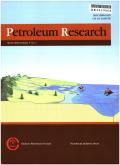Investigation on phase behavior of shale condensate gas under multi-interface effect
IF 4
Q1 Earth and Planetary Sciences
引用次数: 0
Abstract
Shale condensate reservoirs, as a significant unconventional resource, have been gaining increasing interest in recent times. Researchers have developed a variety of models to analyze interfacial effects in nanopores, including capillary condensation, capillarity, and adsorption effects. However, there are few studies on these interface effects. Therefore, we developed a phase equilibrium model considering the multi-interface effects in nanopores. The model is first built by modifying the Peng Robinson-equation of state (PR-EOS). The gas adsorption in vacant solution (FHVSM) model is utilized to describe adsorption. The calculated results show good agreements with experimental data of this model are more consistent with the adsorption characteristics of mixed gases in the porous media. After that, the phase behavior of a typical shale condensate gas is analyzed. Results indicate that the multi-interface effects will result in incremental dew-point pressure and retrograde condensate saturation. Moreover, the injection of CO2 and N2 was also studied, illustrating that CO2 reduces the dew-point pressure, while N2 increases the dew-point pressure. Both CO2 and N2 reduce the retrograde condensate saturation. Finally, the change in the adsorption of mixed gases was also evaluated, which shows a decreasing trend as the reservoir pressure depleted. This work provides deeper understandings in the phase behavior of hydrocarbons in the shale condensate gas reservoirs.
多界面效应下页岩凝析气相行为研究
页岩凝析气藏作为一种重要的非常规资源,近年来受到越来越多的关注。研究人员已经开发了各种模型来分析纳米孔中的界面效应,包括毛细冷凝、毛细作用和吸附效应。然而,对这些界面效应的研究很少。因此,我们建立了考虑纳米孔中多界面效应的相平衡模型。该模型首先通过修正Peng robinson状态方程(PR-EOS)建立。气体在空溶液中的吸附(FHVSM)模型被用来描述吸附。计算结果与实验数据吻合较好,更符合混合气体在多孔介质中的吸附特性。在此基础上,分析了典型页岩凝析气的相行为。结果表明,多界面效应会导致露点压力增加,凝析油饱和度下降。此外,还研究了CO2和N2的注入,表明CO2降低了露点压力,而N2增加了露点压力。CO2和N2都降低了逆行凝析油饱和度。最后,对混合气体吸附量的变化进行了评价,发现随着储层压力的降低,混合气体吸附量呈下降趋势。这项工作为页岩凝析气藏中油气的相行为提供了更深入的认识。
本文章由计算机程序翻译,如有差异,请以英文原文为准。
求助全文
约1分钟内获得全文
求助全文
来源期刊

Petroleum Research
Earth and Planetary Sciences-Geology
CiteScore
7.10
自引率
0.00%
发文量
90
审稿时长
35 weeks
 求助内容:
求助内容: 应助结果提醒方式:
应助结果提醒方式:


